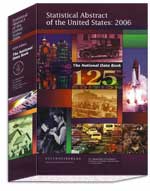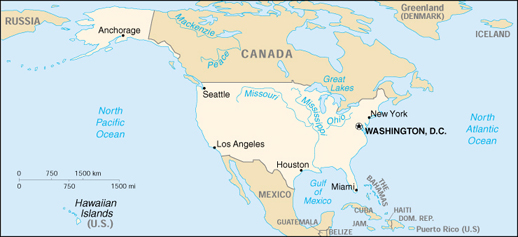 |
|
Geography
Area
(50 states and District of Columbia only):
Total: 9,826,630
sq km
Land:
9,161,923 sq km
Water: 664,707 sq km
Note: Includes only the 50 states and District of Columbia
Comparative Size:
About one-half the size of Russia; about three-tenths the size of Africa;
about one-half the size of South America (or slightly larger than Brazil);
slightly larger than China; about two and one-half times the size of
Western Europe.
Land boundaries:
Total: 12,034 km
Border Countries: Canada 8,893 km (including 2,477 km with
Alaska), Cuba 28 km (US Naval Base at Guantanamo Bay), Mexico 3,141
km
Note: US Naval Base at Guantanamo Bay, Cuba is leased by
the US and is part of Cuba; the base boundary is 28 km
Coastline:
19,924 km
Climate:
Mostly temperate, but tropical in Hawaii and Florida, arctic in Alaska,
semiarid in the great plains west of the Mississippi River, and arid in the Great Basin of the southwest; low winter temperatures in the northwest are ameliorated occasionally in January and February by warm chinook winds from the eastern slopes of the Rocky Mountains
Terrain:
Vast central plain, mountains in west, hills and low mountains in east; rugged mountains and broad river valleys in Alaska; rugged, volcanic topography in Hawaii
Elevation extremes:
Lowest point: Death Valley -86 m
Highest point: Mount McKinley 6,194 m
Natural resources:
Coal, copper, lead, molybdenum, phosphates, uranium, bauxite, gold, iron, mercury, nickel, potash, silver, tungsten, zinc, petroleum, natural gas, timber
Land use:
Arable land: 18.01%
Permanent crops: 0.21%
Other: 81.78% (2005)
Natural hazards:
Tsunamis, volcanoes, and earthquake activity around Pacific Basin; hurricanes along the Atlantic and Gulf of Mexico coasts; tornadoes in the midwest and southeast; mud slides in California; forest fires in the west; flooding; permafrost in northern Alaska, a major impediment to development
People
Population:
301,139,947 (July 2007 est.)
Age structure:
0-14 years: 20.2% (male 31,152,050; female 29,777,438)
15-64 years: 67.2% (male 100,995,752; female 101,365,035)
65 years and over: 12.6% (male 15,858,477; female 21,991,195)
(2007 est.)
Population growth rate:
0.894% (2007 est.)
Birth rate:
14.16 births/1,000 population (2007 est.)
Death rate:
8.26 deaths/1,000 population (2007 est.)
Net migration rate:
3.05 migrant(s)/1,000 population (2007 est.)
Infant mortality rate:
6.37 deaths/1,000 live births (2007 est.)
Life expectancy at birth:
Total population: 78 years
Male: 75.15 years
Female: 80.97 years (2006 est.)
Ethnic groups:
White 81.7%, Black 12.9%, Asian 4.2%, Amerindian and Alaska native 1%,
native Hawaiian and other Pacific islander 0.2%, others 10% (2003 est.)
Note: a separate listing for Hispanic is not included because the US
Census Bureau considers Hispanic to mean a person of Latin American
descent (including persons of Cuban, Mexican, or Puerto Rican origin)
living in the US who may be of any race or ethnic group (white, black,
Asian, etc.)
Religions:
Protestant 52%, Roman Catholic 24%, Mormon 2%, Jewish 1%, Muslim 1%,
other 10%, none 10% (2002 est.)
Languages:
English 82.1%, Spanish 10.7%, other Indo-European 3.8%, Asian and
Pacific island 2.7%, other 0.7% (2000 census)
Economy
GDP:
purchasing power parity - $13.13 trillion (2006 est.)
GDP - real growth rate:
3.2% (2006 est.)
GDP - per capita:
purchasing power parity - $44,000 (2006 est.)
GDP - composition by sector:
agriculture: 0.9%; industry: 20.4%; services: 78.6% (2006 est.)
Population below poverty line:
12% (2004 est.)
Inflation rate (consumer prices):
2.5% (2006 est.)
Labor force:
151.4 million (includes unemployed) (2006 est)
Labor force - by occupation:
farming, forestry, and fishing 0.7%, manufacturing, extraction, transportation,
and crafts 22.9%, managerial, professional, and technical 34.9%, sales
and office 25%, other services 16.5%
note: figures exclude the unemployed (2006)
Unemployment rate:
4.8% (2006 est.)
Budget:
Revenues: $2.409 trillion
Expenditures: $2.66 trillion, including capital expenditures of $NA
(2006 est.)
Industries:
leading industrial power in the world, highly diversified and technologically
advanced; petroleum, steel, motor vehicles, aerospace, telecommunications,
chemicals, electronics, food processing, consumer goods, lumber, mining
Industrial production growth rate:
4.2% (2006 est.)
Agriculture - products:
wheat, corn, other grains, fruits, vegetables, cotton; beef, pork, poultry,
dairy products; forest products; fish
Exports:
$1.024 billion f.o.b. (2006 est.)
Exports - commodities:
capital goods, automobiles, industrial supplies and raw materials, consumer
goods, agricultural products
Exports - partners:
Canada 23.4%, Mexico 13.3%, Japan 6.1%, China 4.6%, UK 4.3% (2005)
Imports:
$1.869 trillion f.o.b. (2006 est.)
Imports - commodities:
crude oil and refined petroleum products, machinery, automobiles, consumer
goods, industrial raw materials, food and beverages
Imports - partners:
Canada 16.9%, China 15%, Mexico 10%, Japan 8.2%, Germany 5% (2006)
Communications
Telephones
- main lines in use:
268,000,000 (2003)
Telephones - mobile cellular:
219.4 million (2005)
Telephone system:
General assessment: a very large, technologically advanced, multipurpose
communications system
Domestic: a large system of fiber-optic cable, microwave radio
relay, coaxial cable, and domestic satellites carries every form of
telephone traffic; a rapidly growing cellular system carries mobile
telephone traffic throughout the country
International: 24 ocean cable systems in use; satellite earth
stations - 61 Intelsat (45 Atlantic Ocean and 16 Pacific Ocean), 5 Intersputnik
(Atlantic Ocean region), and 4 Inmarsat (Pacific and Atlantic Ocean
regions) (2000)
Radio broadcast stations:
AM 4,789, FM 8,961, shortwave 19 (2006)
Television broadcast stations:
more than 2,218 (2006)
Internet Hosts:
195.139 million (2005)
Internet users:
205.327 (2005)
Transportation
Airports:
14,858 (2006)
Heliports:
149 (2006)
Roadways:
total: 6,430,366 km
paved: 4,165,110 km (including 74,009 km of expressways)
unpaved: 2,265,256 km (2005)
Waterways:
41,009 km (19,312 km used for commerce) (2004)
note: navigable inland channels, exclusive of the Great Lakes
Pipelines:
petroleum products 244,620 km; natural gas 548,665 km (2003)
Ports and harbors:
Anchorage, Baltimore, Boston, Charleston, Chicago, Duluth, Hampton Roads,
Honolulu, Houston, Jacksonville, Los Angeles, New Orleans, New York,
Philadelphia, Port Canaveral, Portland (Oregon), Prudhoe Bay, San Francisco,
Savannah, Seattle, Tampa, Toledo
Railways:
total: 226,605 km (2004)
|



